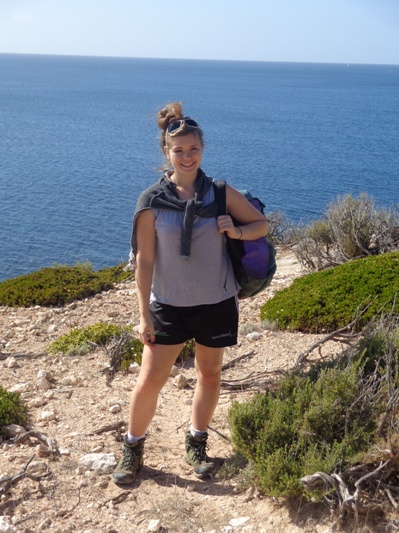Mapping in the Antipodes
 Charlotte-Ellen Eales (University of Birmingham) received a £550 Society Undergraduate Fieldwork Bursary to assist her 42-day sojourn in Kaikoura, New Zealand.
Charlotte-Ellen Eales (University of Birmingham) received a £550 Society Undergraduate Fieldwork Bursary to assist her 42-day sojourn in Kaikoura, New Zealand.
New Zealand is renowned for being a geologically and geothermally active region with extensive mountain ranges, frequent earthquakes and a complex geology. The Kaikoura Peninsula is situated on the east coast of the South island and is composed of six main sedimentary lithofacies ranging from Upper Cretaceous to Miocene in age.
SEDIMENTARY
The peninsula is comprised entirely of sedimentary rocks, including mudstones, limestones and sandstones all of which have been folded and recently uplifted due to the continuing Kaikoura Orogeny. As the rocks in the mapping region are all sedimentary, diagenetic features and other characteristics are crucial to distinguishing lithofacies at Kaikoura. The large dolomitic concretions of the Herring Formation (puiture) are a textbook example of this, while siliceous nodules and distinctive tidal weathering pattern are also indicative of certain facies.
Millimetre-scale calcite veins indicate paleo pore-fluid activity and reflect the carbonate composition of the majority of the facies observed. Structurally the region demonstrates an idealised cross-section of four, kilometre-scale folds, which control the outcrop observed at surface. Metre-scale parasitic folding also exists, especially within the limestone layers, and lateral faults are the most common type of brittle deformation.
Although petroleum plays are not present within the mapping area or its (onshore) vicinity, there are plans to explore and drill in the neighbouring Pegasus and Canterbury Basins. Currently the ownership is dominated by Anadarko but some blocks presently under consultation and others are yet to be released.
EXPLORATION
Exploration in the Pegasus Basin is of deep concern to the Kaikoura community, largely because Kaikoura’s economy depends on tourism. Tourists enjoy recreational fishing, water activities, bird spotting, whale watching and other marine life excursions, all of which rely on a pristine marine environment. Hence the danger posed by any oil-spill disaster would be exceptionally great for both the Kaikoura community and marine life. Concerns centre on the risk of developing deep wells (>2700m) in a seismically active region prone to mega-thrust earthquakes. Additionally, many also fear that New Zealand’s infrastructure and maritime services do not presently have the capacity to cope with a serious spill.
The Kaikoura community along with many similar coastal communities in New Zealand will continue to protest against offshore exploration and support green energy as an alternative means of economic growth, despite exploration plans having already been approved.
I would like to thank the Geological Society and Novas Consulting for their support for my undergraduate mapping project.